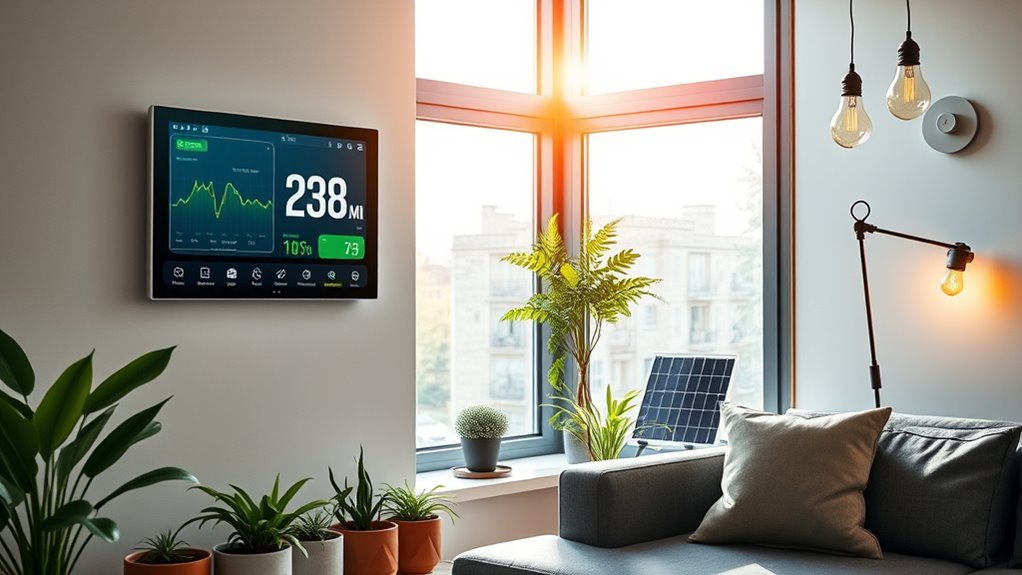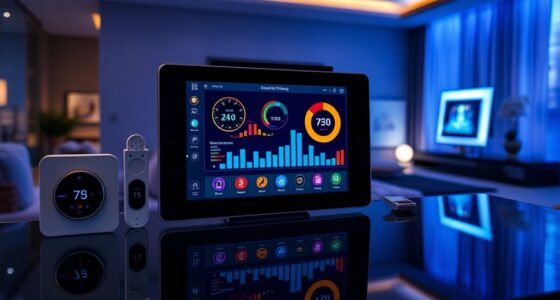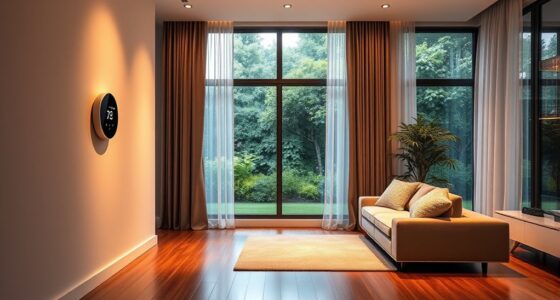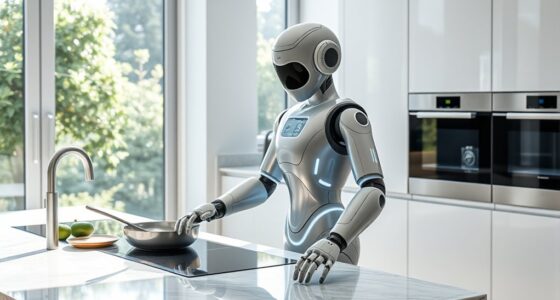Sustainable smart home technology helps you save energy and reduce your environmental impact through green gadgets and automation. You can use energy-efficient LED bulbs, smart thermostats, and interconnected systems that optimize heating, cooling, and lighting based on occupancy and natural light. Monitoring tools let you track your usage and make smarter choices. If you continue, you’ll discover how integrating these innovations can make your home more eco-friendly and cost-effective.
Key Takeaways
- LED lighting and smart controls significantly reduce electricity consumption and carbon footprint in homes.
- Smart thermostats optimize heating and cooling, lowering energy waste and extending HVAC lifespan.
- Integration of interconnected devices creates a cohesive, eco-friendly environment that enhances energy efficiency.
- User-friendly apps and monitoring tools enable homeowners to track energy use and make sustainable appliance choices.
- Small adjustments in lighting, climate, and system management contribute to long-term cost savings and environmental benefits.
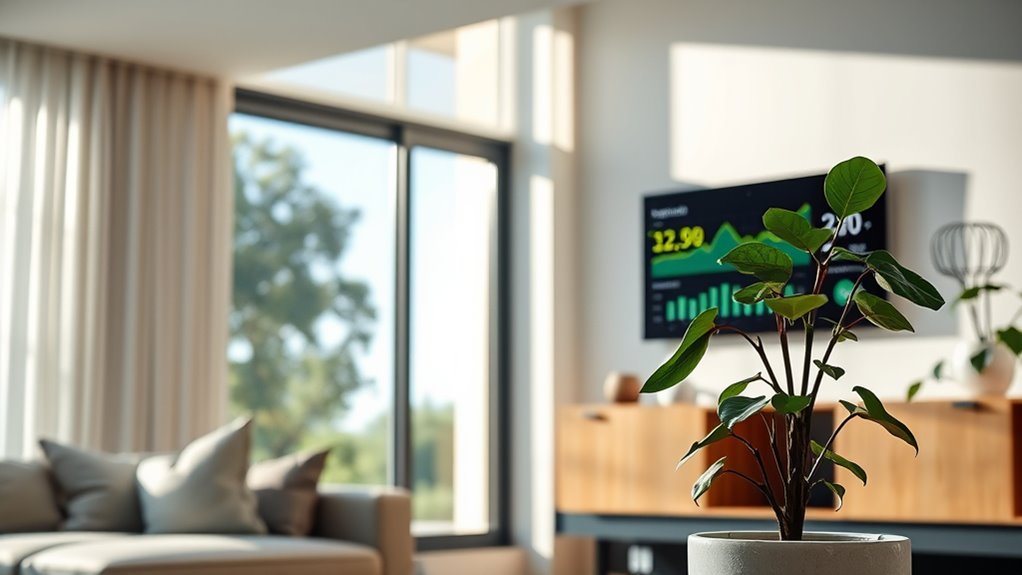
Have you ever wondered how your home can become more efficient and connected? With smart home technology, you can reduce energy consumption while enjoying greater convenience and comfort. One of the simplest ways to start is by upgrading your lighting system. Energy efficient lighting, such as LED bulbs, uses considerably less power than traditional incandescent bulbs. Coupled with smart lighting controls, you can schedule lights to turn off when you’re not in a room or adjust brightness based on natural light levels. These small changes may seem minor, but collectively they make a big impact on your energy bills and carbon footprint.
Automated climate control is another key feature that boosts your home’s sustainability. Instead of manually adjusting your thermostat, you can install smart thermostats that learn your schedule and preferences. They automatically lower the temperature when you’re away and raise it when you’re returning, ensuring comfort without wasting energy. These systems often include sensors that detect occupancy and ambient conditions, fine-tuning heating and cooling to match your daily routines. This not only conserves energy but also extends the lifespan of your HVAC system by reducing unnecessary strain.
Smart thermostats learn your schedule to optimize comfort and energy savings while extending HVAC system lifespan.
Integrating energy efficient lighting with automated climate control creates a seamless, eco-friendly environment. Imagine walking into a room where the lights dim to match the natural daylight, and the temperature adjusts to your comfort level, all without lifting a finger. These smart systems communicate with each other, optimizing energy use throughout your home. For example, if you leave a window open, your smart climate control might temporarily reduce heating or cooling to prevent energy waste. This interconnected approach ensures your home remains comfortable and green, all while saving you money over time.
Implementing these technologies is easier than you might think. Many smart devices are compatible with popular home automation platforms, allowing you to set schedules, create scenes, and monitor energy consumption from your smartphone. You can even receive alerts if something requires your attention, so you stay in control without effort. Over time, these systems learn your habits, becoming more efficient and personalized, which maximizes savings and minimizes environmental impact. Additionally, understanding energy consumption through labels and monitoring can help you make smarter choices in your appliance upgrades.
Frequently Asked Questions
How Do Smart Home Devices Reduce Overall Energy Consumption?
Smart home devices reduce your overall energy consumption by using energy monitoring to track usage patterns and identify inefficiencies. Automation efficiency comes into play when systems automatically adjust lighting, heating, and appliances based on your habits and preferences, ensuring nothing runs wastefully. By optimizing these functions, you save energy, lower utility bills, and reduce your environmental impact without sacrificing comfort or convenience.
Are Sustainable Smart Gadgets More Cost-Effective Long-Term?
Yes, sustainable smart gadgets are more cost-effective in the long run. You’ll see significant cost savings through reduced energy bills, thanks to their efficient operation. Plus, these devices lower your environmental impact by conserving resources and cutting waste. Although they might cost more upfront, the savings over time make them a smart investment, benefiting both your wallet and the planet.
What Are the Best Eco-Friendly Materials for Smart Home Installations?
You should choose smart home installations made from recyclable materials like aluminum or glass, which you can easily repurpose or recycle. Opt for biodegradable components such as plant-based plastics or organic insulation to reduce environmental impact. These eco-friendly materials not only support sustainability but also help you lower your carbon footprint, making your smart home more eco-conscious and aligned with green living principles.
How Can Smart Homes Promote Water Conservation?
You can promote water conservation by installing water-saving fixtures like low-flow showerheads and faucets, which reduce water use without sacrificing performance. Additionally, incorporating leak detection systems helps you identify and fix leaks early, preventing water waste. These smart solutions allow you to monitor your water consumption in real-time, making it easier to adopt conservation habits and save resources while maintaining a comfortable, eco-friendly home.
Are There Government Incentives for Installing Green Smart Home Technology?
Yes, there are government incentives available for installing green smart home technology. You can benefit from government grants and tax credits that help offset the costs of eco-friendly upgrades. These programs aim to encourage sustainable living by making smart home innovations more affordable. Check with local and federal agencies to find specific grants and tax incentives in your area, ensuring you maximize your savings while reducing your environmental impact.
Conclusion
By embracing sustainable smart home technology, you’re turning your house into a green oasis that breathes life into conservation efforts. These gadgets act like eco-friendly superheroes, saving energy and reducing waste with every use. As you incorporate smarter, greener solutions, you’ll not only cut costs but also help protect our planet for future generations. Think of your home as a living, breathing forest—thriving because of your commitment to smarter, greener choices.
